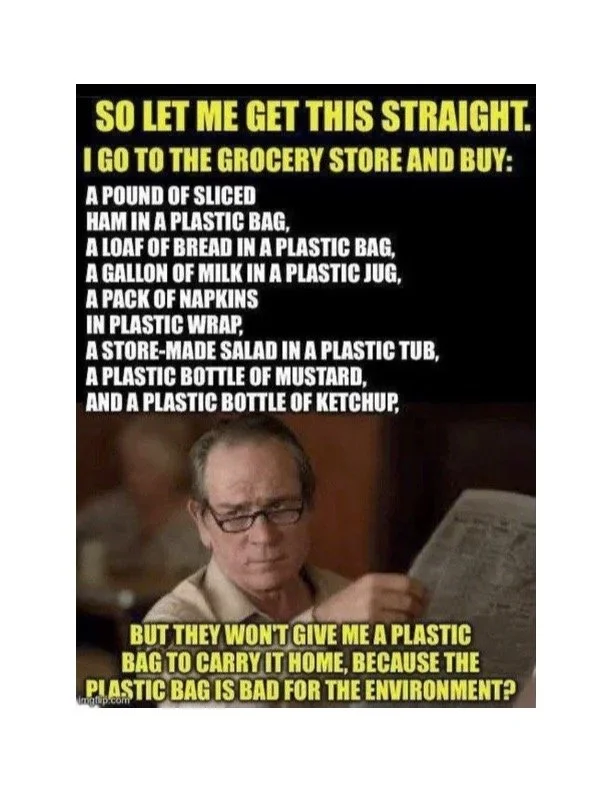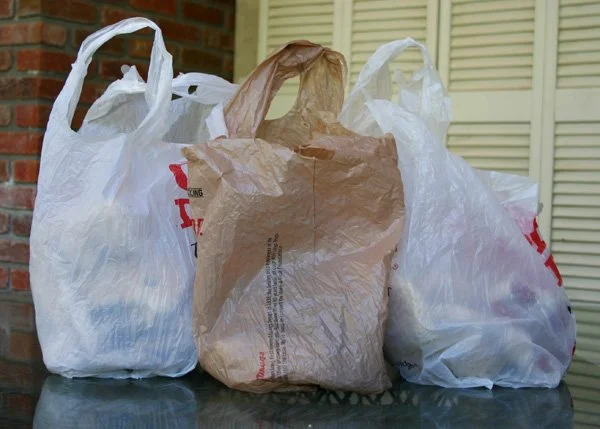Its In the Bag!
There’s a meme going around that speaks to the logic employed (or lack thereof), regarding the banning of plastic shopping bags. The premise of the meme expounds on the use of plastic in packaging all the products at the grocery store, but then, allegedly to reduce the volume of single use plastics, bans the plastic bag that had been used for decades to take those products home (and were likely reused for small can garbage bags, lunch bags, etc). So within the framework of the grocery world, but then expanding out to much of the retail market, for all types of goods, there has been an interesting shift regarding what had been a generally accepted accommodation to the customers, a free vehicle to carry out your purchases.
For decades, grocery shoppers had their bags packed, by a “bag boy” (updated to a “bag person”), even double bagged when requested, in paper grocery sacks. And there was no charge for this service. That was in the days when front end help included a cashier and a bag person, and just as the cashier was trained to know what items were to be rung on Produce and what was Grocery and what was taxed, the bag persons were trained in the art of packing a grocery bag, ensuring your tomatoes and eggs got home safely and unbroken. Eventually when the plastic “T-sack bag” innovation became accepted by the likes of Kroger and Safeway, one may assume the same training, with some slight adjustments for the new design features, was deployed. And the plastic T-sack bag was soon ubiquitous in all grocers, local, regional and national chains, bodegas, convenience stores and corner markets. It didn’t end there though. Many foodservice operators adopted the T-sack bag for carry out orders. Then retailers of all types found it to be a cost saving and utilitarian option.
But in a never ending quest to lower costs, including labor costs, soon the “bag person” went by the wayside as a fixture at the grocery store’s front end. Now cashiers, with automated scanning taking a good bit of the complexity of their jobs out of the equation, were expected to scan the groceries and pack them as well, or accept help from the customers. To be fair, many customers started helping to pack their own groceries, once the “bag person” training efforts fell by the wayside within many grocery chains. Poorly packed groceries by untrained personnel resulted in a bit of customer dissatisfaction, but recognizing that there was little likelihood of those salad days of professional front end grocery help returning, customers decided they could do it better. This didn’t go unnoticed by the grocery chains’ corporate offices. So the next step shouldn’t have come as the surprise it did.
Once upon a time, when you went to the grocery store, there were multiple check out lanes. Each of those check out lanes had a cashier and a bag person. Over time, with the development of new technology, there were multiple lanes and each lane had a cashier, and you had the choice of letting the cashier pack your groceries, or pack your own groceries. Time marched on and then there were multiple lanes, but only a couple of lanes had a cashier during off peak hours. But there was a new innovation too; the self check out kiosk. So now you had the option of shopping for your groceries, checking out your groceries and packing your own groceries. Well, we should’ve seen it coming, because they always told us technology would be a major factor in labor saving processes. We just didn’t realize the labor saving would be accomplished by foisting the labor back on the customers.
Not only do you pay for your items, you’re paying to do someone’s job!
Let’s get back to the bags though. So again, once upon a time, the grocery store carried a full slate of various sized paper grocery bags to accommodate most any shopper’s grocery cart. Then it was decided that most grocery shoppers’ basket of goods would be best packed in a grocery sack (1/6 barrel to be precise), so most grocers started offering one option for packing groceries at the check out lane. Then the plastic T-sack bag appeared as the next best thing and grew to dominate the space, accounting for over 80% of all bags used by the grocery industry. Unfortunately, their ubiquity and their lightness and people’s general lackadaisical attitudes toward proper waste management, the plastic T-sack bag began to show up on roadsides, fields, river basins, lakeshores and the ocean, rather than in the waste bin (or recycling receptacle), where they belonged. As a result, they became a target for the blame associated with all poorly disposed waste and soon many municipalities and communities started taking legal actions to restrict or eradicate their use.
Being lightweight and inexpensive may have been a double edged sword.
And so all that is old is new again, and when one entered the grocery store next, paper bags were back, but now with handles, that sometimes worked and quite often, to the chagrin of the grocery operators, failed.
Handles on paper grocery bags seemed like a good idea at the time…
The story doesn’t end there however. Once again the corporate offices at the nation’s grocery chains started lamenting over the fact that the cost of the new handled paper grocery sacks (an item that in a slightly different form in prior decades had been a staple for the store’s front end, and accepted as a “cost of doing business”) were significantly higher than the plastic T-sacks that had become the industry standard. They appealed to their marketing teams to come up with a way to defray some of these costs. This likely explains the sudden and prominent displaying of reusable bags to transport the purchases the customer made at the grocery store. Ironically, many of these were constructed of plastic materials, but apparently deemed less odious than the T-sack that was being phased out.
Reusable bags, many made from recycled plastics
As mentioned, some chains moved from the plastic T-sack to handled paper grocery sacks. However others, understanding the significant impact the higher cost of these paper sacks might create, started notifying their customers that as of a certain date, you either had to bring your own shopping bags or buy shopping bags as you checked out. In fact, recently the usual question of “Paper or Plastic?” has been updated in many regions to “How many bags will you be purchasing today?
Let me be clear: This is not an essay meant to question, decry or even opine regarding the legislative decisions and/or societal attitudes toward single use plastics, plastic t-sacks, grocery chain staffing decisions or any of the other elements in the narrative above. What I hope any reader would take away from this essay is the recognition that the market place is a dynamic entity where the intersection of supply and demand, societal influences, customer behavior, supplier behavior, business sustainability practices and evolving technology require the entrepreneurs operating within this space to identify, acknowledge, regard, assess and interact with, in order to achieve success. Most often, our businesses do not exist in a perfect environment of our choosing. They operate as part of the market that is subject to dynamic influences and often, the chaos of the real world. Often those influences, those dynamic forces, don’t follow the confines of logical arguments; often they make no sense. But the agile entrepreneur accepts the chaos, aligns his resources, makes the course corrections and learns from the experience. That should be considered a true definition of success.






